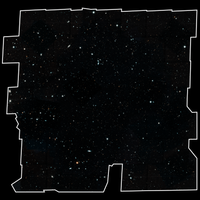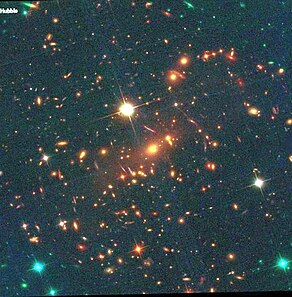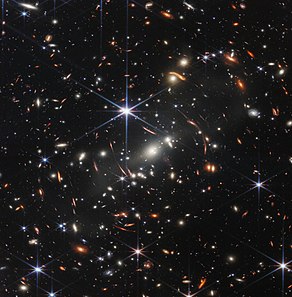
Back قائمة الحقول العميقة Arabic فهرست زمینههای ژرف Persian Liste des champs profonds French Lista głębokich pól Polish Список сверхдальних обзоров Russian گہری فیلڈز کی فہرست Urdu
In astronomy, a deep field is an image of a portion of the sky taken with a very long exposure time, in order to detect and study faint objects. The depth of the field refers to the apparent magnitude or the flux of the faintest objects that can be detected in the image.[2] Deep field observations usually cover a small angular area on the sky, because of the large amounts of telescope time required to reach faint flux limits. Deep fields are used primarily to study galaxy evolution and the cosmic evolution of active galactic nuclei, and to detect faint objects at high redshift. Numerous ground-based and space-based observatories have taken deep-field observations at wavelengths spanning radio to X-rays.
The first deep-field image to receive a great deal of public attention was the Hubble Deep Field, observed in 1995 with the WFPC2 camera on the Hubble Space Telescope. Other space telescopes that have obtained deep-field observations include the Chandra X-ray Observatory, the XMM-Newton Observatory, the Spitzer Space Telescope, and the James Webb Space Telescope.
- ^ "Hubble Assembles Wide View of the Distant Universe". www.spacetelescope.org. Retrieved 3 May 2019.
- ^ a b Pacucci, Fabio (15 July 2022). "How Taking Pictures of 'Nothing' Changed Astronomy - Deep-field images of "empty" regions of the sky from Webb and other space telescopes are revealing more of the universe than we ever thought possible". Scientific American. Retrieved 16 July 2022.
- ^ Chow, Denise; Wu, Jiachuan (12 July 2022). "Photos: How pictures from the Webb telescope compare to Hubble's - NASA's $10 billion telescope peers deeper into space than ever, revealing previously undetectable details in the cosmos". NBC News. Retrieved 16 July 2022.
- ^ Garner, Rob (11 July 2022). "NASA's Webb Delivers Deepest Infrared Image of Universe Yet". NASA. Archived from the original on 12 July 2022. Retrieved 12 July 2022.
- ^ Overbye, Dennis; Chang, Kenneth; Tankersley, Jim (11 July 2022). "Biden and NASA Share First Webb Space Telescope Image – From the White House on Monday, humanity got its first glimpse of what the observatory in space has been seeing: a cluster of early galaxies". The New York Times. Archived from the original on 12 July 2022. Retrieved 12 July 2022.
- ^ Deliso, Meredith; Longo, Meredith; Rothenberg, Nicolas (14 July 2022). "Hubble vs. James Webb telescope images: See the difference". ABC News. Retrieved 15 July 2022.
- ^ Kooser, Amanda (13 July 2012). "Hubble and James Webb Space Telescope Images Compared: See the Difference - The James Webb Space Telescope builds on Hubble's legacy with stunning new views of the cosmos". CNET. Retrieved 16 July 2022.
- ^ Atkinson, Nancy (2 May 2022). "Now, We can Finally Compare Webb to Other Infrared Observatories". Universe Today. Archived from the original on 10 May 2022. Retrieved 12 May 2022.
© MMXXIII Rich X Search. We shall prevail. All rights reserved. Rich X Search



